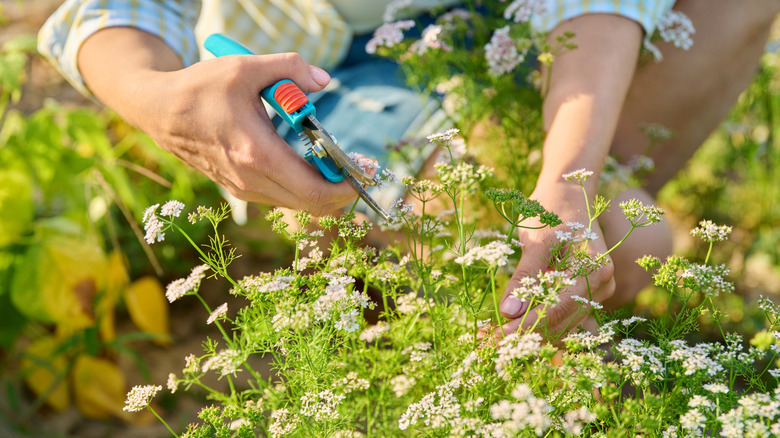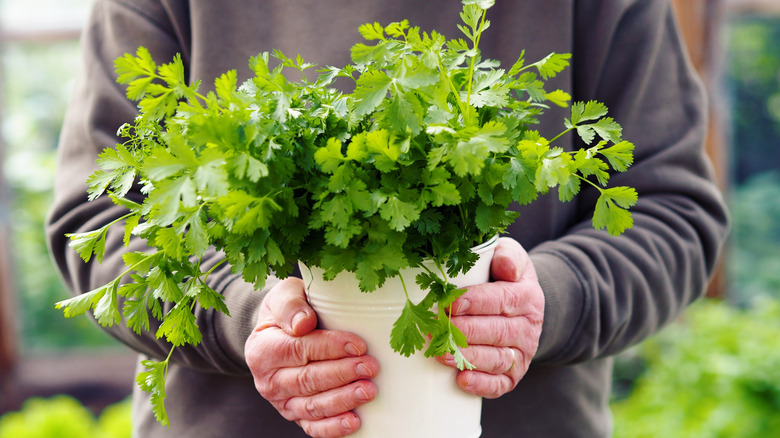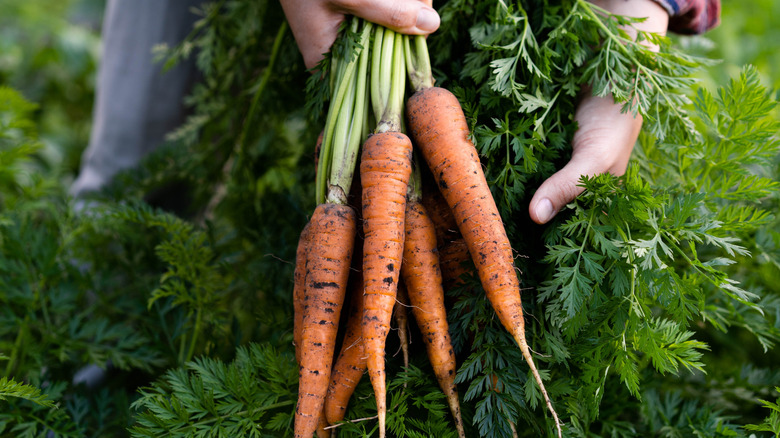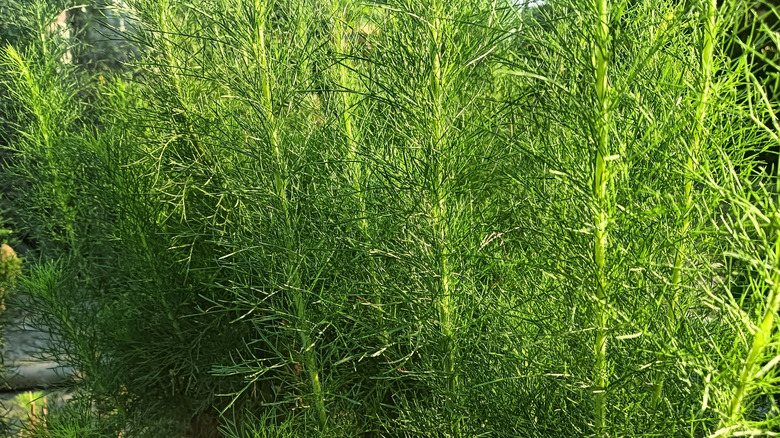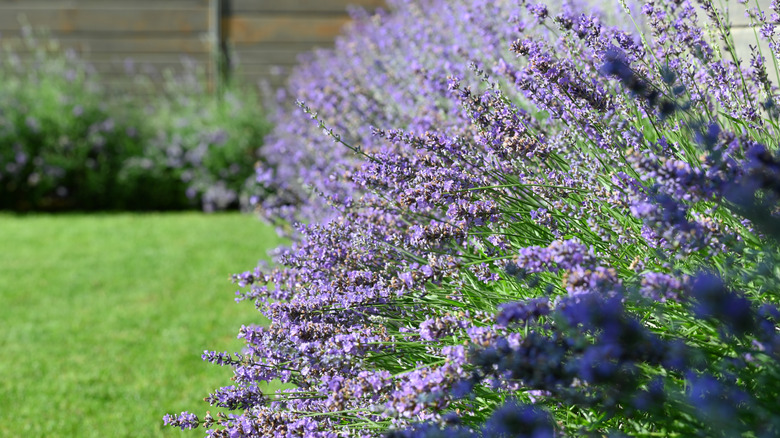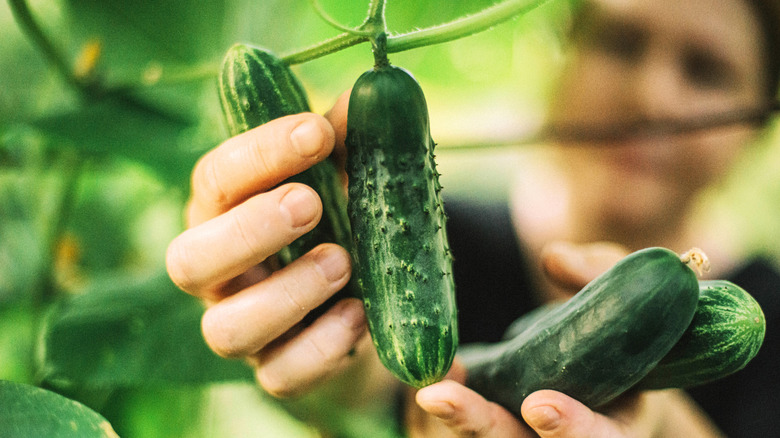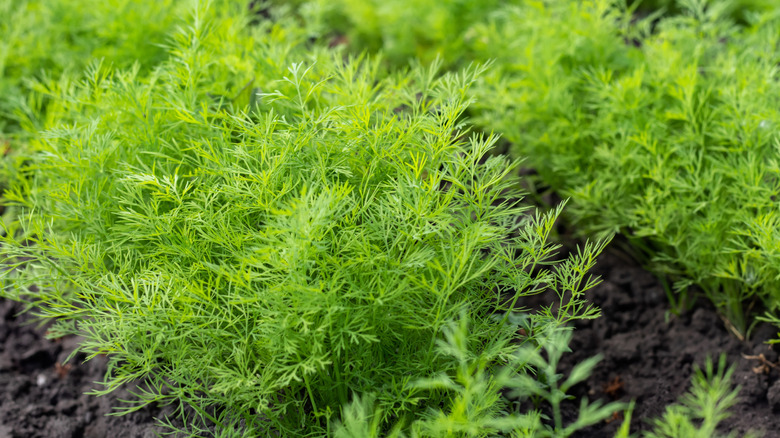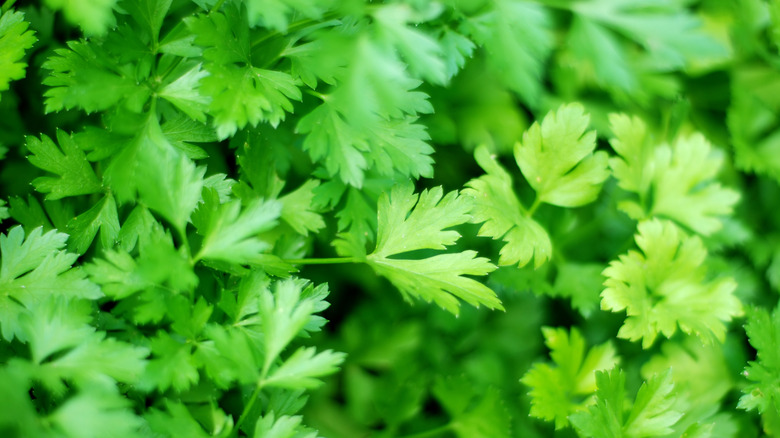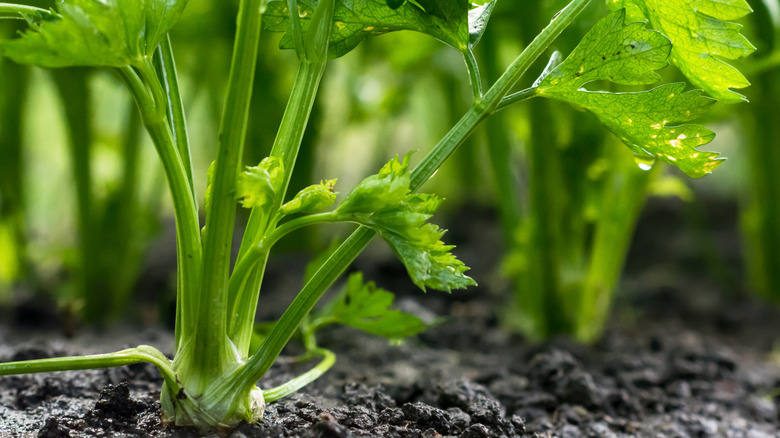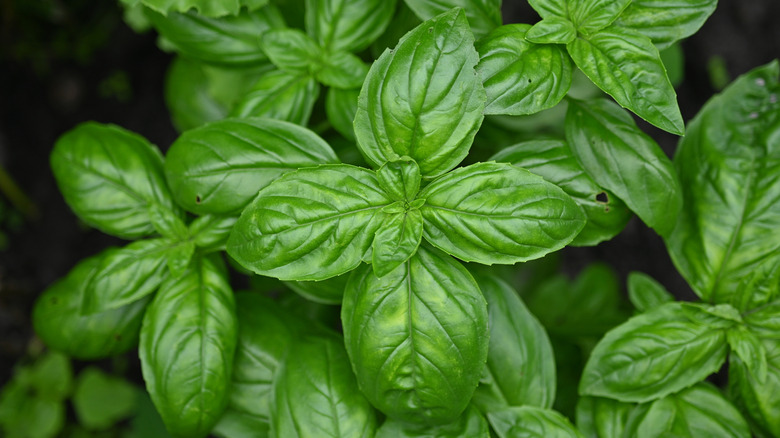8 Herbs And Vegetables To Avoid Growing Near Cilantro In The Garden
We may receive a commission on purchases made from links.
Cilantro is somewhat of a controversial herb for gardeners and foodies. Some absolutely love its fresh taste, while others, particularly those with the OR6A2 gene, feel using it results in food tasting like you've prepared it using a bar of soap. But if you're someone who's pro-cilantro, then you need to give it the best growing conditions possible, and that includes giving it good neighbors.
Growing Coriandrum sativum next door to the wrong plants can result in some devastating (or, at the very least, frustrating) issues that make all your plants unhappy. So rather than winging it, take a note from us and keep these eight herbs and vegetables away from your cilantro plant to ensure every plant flourishes. But, don't worry if you had your heart set on a certain pairing, because we'll include a few options that make similar alternatives for either cilantro or the bad neighbor.
What cilantro needs to thrive
Let's do a quick run over what growing conditions cilantro needs to thrive. First, a clarification: Coriandrum sativum is the name of the whole plant. Cilantro refers to the leaves and stems that are considered the herb. Coriander refers to the seeds that are ground up and used as a spice. So, when people mistake one for the other, they technically aren't wrong, but it's important to know the difference, especially if you're using it for cooking.
Growing and caring for a cilantro plant takes perseverance, as it's a little bit of a diva and will freak out if things veer too far off its preferred spectrum. Coriandrum sativum needs well-draining soil that stays consistently moist with a pH around 6.5. It likes full sun but cannot tolerate high heat and will develop a bitter taste if allowed to flower in summer temperatures. Paradoxically, it does great in cooler temperatures but will only tolerate so much shade before it starts to wilt. It also hates lots of rain or high humidity.
Ideally, plant cilantro in a pot or garden during the mid-to-late spring months when the soil is still kind of moist from leftover winter runoff or dew. Make sure it gets a lot of sun, harvest any coriander seeds from its flowers, then cut it back before the peak of summer so that it doesn't get leggy or look like a ball of crispy, scalded leaves.
Carrots are too similar to cilantro for both to thrive
Cilantro is part of a big happy family known as Apiaceae, AKA carrot. You might think having a family reunion in your garden would be a good thing. But it's the opposite. When plants that are too similar are grown together, it can lead to problems that can quickly become catastrophic. This is mainly because they catch the same diseases or attract the same pests. If one plant becomes infected, the other is likely to follow. However, if you plant cilantro next to a species that is immune to its pests or diseases, it will grow unscathed next to it. Unfortunately, cilantro and carrots (Daucus carota subsp. sativus) are just too similar to be planted close together.
However, cilantro does play well with some other tasty roots and veggies. In particular, cilantro can keep aphids and spider mites away from potatoes (Solanum tuberosum) and eggplants (Solanum melongena). If you need good neighbors for carrots, rosemary (Salvia rosmarinus) or sage (Salvia officinalis) would be better companion plants.
Fennel and cilantro can have cross-pollination issues
Fennel (Foeniculum vulgare) is a yummy herb in the Apiaceae family that has similar growing condition requirements to cilantro: full sun and moist soil. It also makes a good filler for those weird, bare spots in your garden which is why so many gardeners love to use fennel as an alternative to ornamental grasses. Unfortunately, fennel is a particularly poor companion for cilantro because it's too closely related in the family tree. In addition to being susceptible to the same pests and diseases, what may happen is that your fennel and cilantro could cross-pollinate, ruining seed production for both plants, reducing their quality and flavor.
If you want a plant that can give you a fennel-like taste but works better with cilantro, try anise (Pimpinella anisum) instead. If you've already planted fennel, you'll need to find plants that can handle its allelopathic properties (compounds that prevent neighbors from outcompeting it for resources), like sunflowers (Helianthus spp.) or yarrow (Achillea spp.)
Lavender needs drier soil than cilantro
Lavender (Lavandula angustifolia) is one of our favorite plants to grow in tough places outdoors because it's not just a pretty face. It's a hard worker that will put on a show without much help from you. Lavender loves sandy soil that's well-draining and prefers to be left alone. It hates getting too much water or fertilizer, and lay off the mulch, too, or it may start to rot. While it loves the sun as much as cilantro, the conflicting soil requirements will make one of the two herbs sad. Either lavender will rot in cilantro's need for moisture, or cilantro will dry out waiting for lavender to eventually need a drink of water.
If you want a purple, showy plant that plays nicer with cilantro, try asters or the butterfly bush (Buddleja). Both are hardy flowers that attract pollinators and give your garden an aesthetic appeal. Meanwhile, oregano (Origanum vulgare) and thyme (Thymus) are two beautiful plants that pair nicely with lavender and make excellent cilantro replacements.
Cucumbers can have stunted growth because of cilantro
Cucumbers are an interesting plant. They're commonly found in gardens around the world and are considered easy to grow, but they're sensitive little guys that can't be near anything too strong. Researchers believe that cucumbers are susceptible to stunted growth caused by environmental stressors in their soil. In particular, gardeners are warned not to plant them next to anything considered aromatic as the herbs could keep them from thriving.
If you want something that can work with cilantro's aroma and not against it, try planting okra (Abelmoschus esculentus), asparagus (Asparagus officinalis), or leafy greens like spinach (Spinacia oleracea) and cabbage (Brassica oleracea) instead. Meanwhile, cucumbers do better when near plants that can act as trap crops that lure pests away, like nasturtiums (Tropaeolum majus) or dill (Anethum graveolens).
Dill is too susceptible to the same problems as cilantro
Dill (Anethum graveolens) might look like its cousin fennel, but its strong aroma quickly lets you know which herb you're dealing with. Since it's a cousin to fennel, that also makes it a cousin to cilantro, which means it's susceptible to the same problems. Aphids, in particular, are a big problem, so one tiny colony can wreak havoc across both herbs quickly before you even notice an outbreak. Plus, its preference for slightly acidic soil conditions means it's just not going to be as happy as it could be if it were somewhere else.
If you want to find something a little more tolerant of cilantro's ideal conditions, try a hardy herb like lemongrass (Cymbopogon citratus). It can handle a wide range of soil types, as long as it gets its full sun and is somewhat resistant to pests. On the other hand, if you've already got dill planted try giving cumin (Cuminum cyminum) a shot. Not only are they good companion plants that have similar growing condition preferences but their flavors make an excellent pairing for cooking.
Parsley is vulnerable to the same pests as cilantro
Parsley (Petroselinum crispum) is another leafy herb from the Apiaceae family, so you know why it's here. It's a shame because it really has near-identical growing conditions: moist but well-draining soil, full sun but tolerant of some shade, and loves the cooler weather months. Unfortunately, it needs to stay away from its family members in order to thrive, and that means steering clear of cilantro. Remember that good companion planting works when neighboring plants and herbs work in congruence, doing the heavy lifting in one area while the other picks up the slack in another. Since cilantro and parsley are so alike, they could end up competing for the same resources, sharing the same pest problems, and stressing one another out to the point that neither gives you a great herb harvest.
That said, parsley does well in a hanging basket, so if you're dead set on growing them near each other, you can make it happen by using something like this three pack of 8.3-inch hanging planters. Just keep them spaced apart and in separate containers to prevent competition. But if you'd rather play it safe, the broad-leafed thyme (Thymus pulegioides) or bay laurel (Laurus nobilis) are both leafy herbs that would fare better next to cilantro.
Celery is just as vulnerable to aphids as cilantro
Celery's scientific name, Apium graveolens, was coined after scientists noticed bees were really attracted to it. Thus, its taxonomy was cemented, roughly translating from Latin to "bees, strong-smelling (but not in a good way)." Maybe we're scent-blind to its smell — who knows? Regardless, celery's graveolens-ness may not be strong to us, but it is strong to a variety of critters that love to munch on it and cilantro. You see, cilantro and celery are both part of the Apiaceae family, so whatever graveolens celery has will undoubtedly attract aphids, earwigs, nematodes, you name it, to its neighbor cilantro and vice versa.
In the end, it's best to save the graveolens for something else better equipped to handle it. Try something more pest-resistant for a cilantro neighbor, like lemon balm (Melissa officinalis) or catmint (Nepeta cataria). If you want a companion plant that will protect celery, try nasturtiums (Tropaeolum majus) or onions (Allium).
Basil likes warmer temperatures while cilantro likes it cool
Is there anything more awesome than fresh basil (Ocimum bas ilicum)? Its aroma is one of the most quintessential "herb" smells ever, at least in our opinion. Basil loves moist, well-draining soil, so you'd think it'd go well with cilantro, but they're not meant to be BFFs. Unfortunately, the cooler temperatures that cilantro needs are too chilly for tropical-climate native basil, especially if you're growing them together as part of an indoor herb garden. In an outdoor setting they could work better; just harvest your cilantro before the temperature heats up and use the newly-available space for your basil. That way, you'll get the best of both herbs and save valuable garden room that can go towards something just as delicious.
However, not all hope is lost for cilantro growers. The "Dolly" variety of the Genovese basil is known to be more cold-tolerant than other cultivars, so if you can find a few seeds, it might be worth testing to see how it fares in your climate. You can also try a hardier cousin of basil to grow with cilantro, like one of the mints; just be prepared that some mints may become a nuisance if you don't keep it pruned. Meanwhile, oregano (Origanum vulgare) and asparagus (Asparagus officinalis) make excellent companion plants that thrive alongside basil instead of cilantro.
